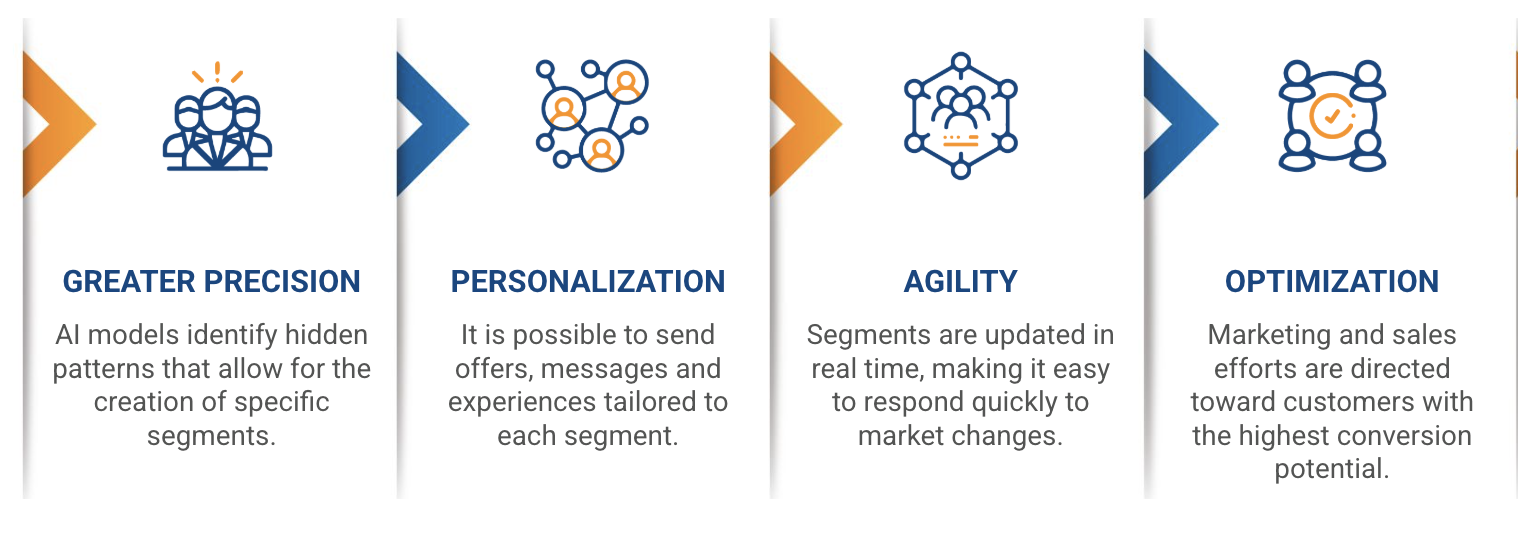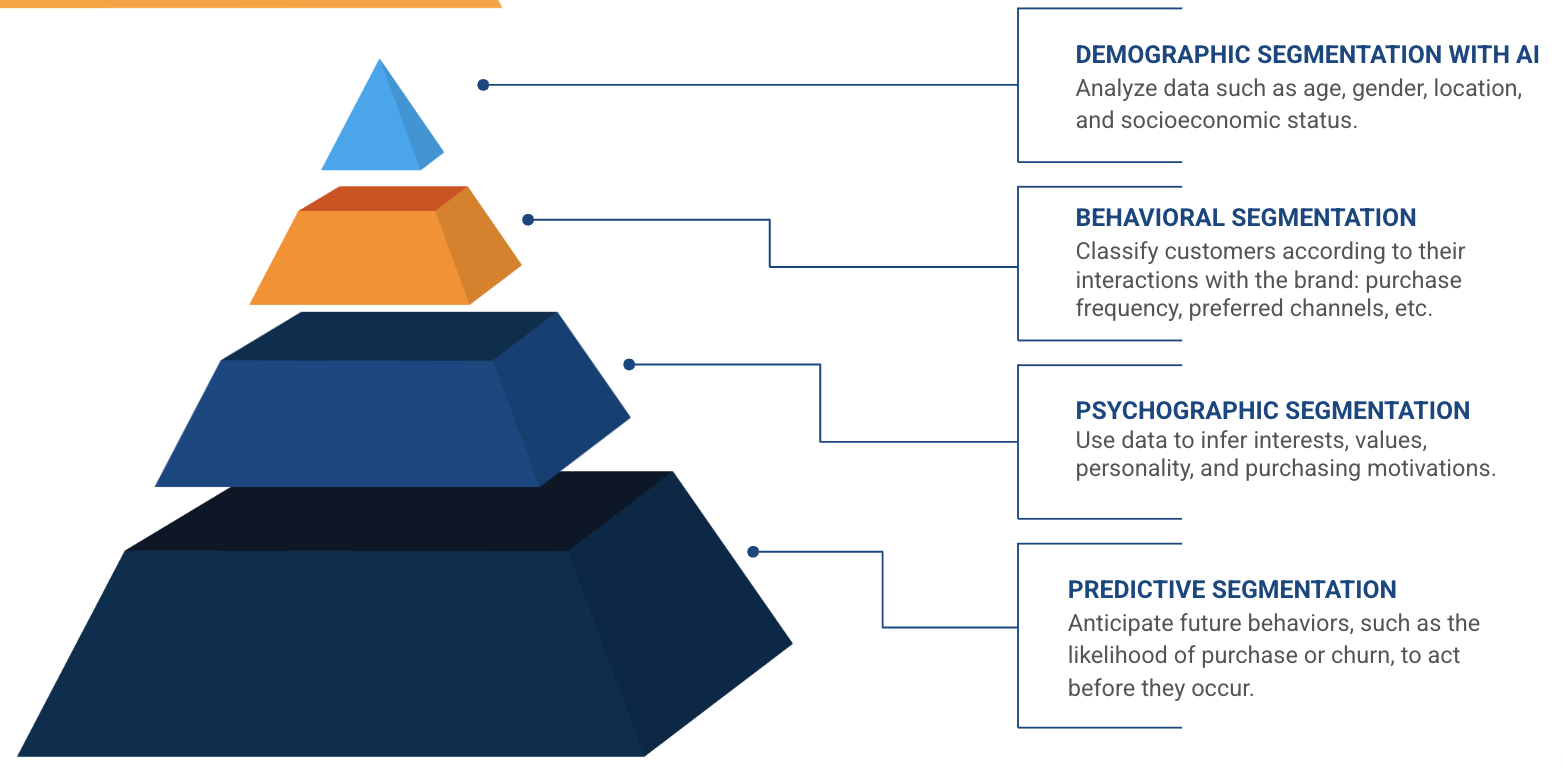
Customer segmentation with AI: What it is, how It works, and how to implement it
Table of contents
Quick Access

Deeply understanding your customers is essential for making strategic decisions that drive business growth.
Customer segmentation with AI (Artificial Intelligence) is one of the most powerful tools for achieving this, as it allows you to classify and understand consumers more accurately, efficiently, and in real time than traditional methods.
This article explains what customer segmentation with AI is, how the process works, what benefits it offers, and what aspects a business leader should evaluate before implementing it.

What is AI customer segmentation?
AI Customer Segmentation is the process of dividing a customer base into smaller, more homogeneous groups using Artificial Intelligence algorithms. Unlike traditional segmentation, which is typically based on general criteria such as age, location, or income, AI analyzes large volumes of data and detects complex patterns that the human eye wouldn't be able to identify.
This means the company can understand not only who its customers are, but also how they think, what they prefer, how they interact with the brand, and how likely they are to purchase or abandon the service.
“By leveraging AI, companies can go beyond static segmentation based on demographics and implement dynamic, behavior-based models that continuously evolve with customer interactions,” they noted in an AWS article on the topic.
How AI customer segmentation works
AI customer segmentation combines data analysis with machine learning. The process typically includes the following steps:
1. Data collection
AI integrates information from multiple sources: CRM, social media, purchase histories, website interactions, surveys, among others.
2. Data preprocessing
The information is cleaned and organized to eliminate duplicates, correct errors, and standardize formats. This is key for the model to learn from quality data.
3. Analysis and modeling
Machine learning algorithms detect patterns and relationships in data. Techniques such as clustering, predictive analytics, and neural networks are used to identify segments.
4. Creating dynamic segments
Unlike static segmentation, groups are automatically updated as customers generate new data.
5. Integration with business flows
Segments connect with marketing, sales, or customer service tools to personalize messages and offers in real time.

Benefits of AI-powered customer segmentation for business leaders
For a manager or director, AI-powered customer segmentation is not just a technical improvement, but a strategic enabler that impacts multiple areas of the business.
Increased accuracy
AI models identify hidden patterns that allow for the creation of extremely specific and relevant segments.
Personalization at scale
It's possible to send tailored offers, messages, and experiences to each segment without proportionally increasing costs.
Agile decision-making
Segments are updated in real time, making it easier to respond quickly to changes in the market or customer behavior.
Resource optimization
Marketing and sales efforts are directed toward customers with the highest conversion potential, reducing budget waste.

Types of AI customer segmentation
AI customer segmentation can take different approaches depending on business objectives and the nature of the available data:
AI demographic segmentation
It analyzes data such as age, gender, location, and socioeconomic status, but with deeper insight by cross-referencing variables and identifying specific subgroups.
AI behavioral segmentation
It classifies customers based on their interactions with the brand: purchase frequency, preferred channels, campaign responses.
Psychographic segmentation with AI
Use data to infer interests, values, personality, and purchasing motivations.
Predictive segmentation with AI
Anticipate future behaviors, such as the likelihood of purchase or churn, so you can act before they happen.

Key aspects for implementing AI-Powered customer segmentation in the enterprise
Before investing in an AI-powered customer segmentation solution, business leaders should consider certain critical factors to maximize ROI:
Quality and quantity of available data
AI requires rich and varied data to produce accurate segmentations. An incomplete or outdated database will reduce effectiveness.
Integration with existing systems
It is essential that the tool connects with CRMs, marketing platforms, and other internal systems to seamlessly execute campaigns.
Internal resources and capabilities
Having trained personnel to interpret the results and translate them into concrete actions is just as important as the technology itself.
Regulatory compliance and privacy
Data protection laws (such as GDPR or local laws) require transparency in the use of personal information. The AI solution must comply with these standards.
Vendor evaluation
Reviewing success stories, technical support, and customization capabilities is key to choosing the right technology partner.
Practical example of customer segmentation with AI
Let's imagine a retail chain that implements customer segmentation with AI. The system analyzes millions of transactions, online purchase history, physical store visits, social media interactions, and search patterns on its website.
It identifies a segment of young customers who buy sustainable fashion products and respond well to promotions on Instagram.
It identifies a group of frequent buyers who purchase household items every two months and prefer to receive coupons by email.
It recognizes customers at risk of churn because they have reduced their purchasing frequency, allowing for the activation of retention campaigns.
The result: a 20% increase in sales to priority segments and a 15% reduction in the churn rate in six months.

Future of AI customer segmentation
AI customer segmentation will evolve toward greater automation and precision, thanks to advances such as:
- Generative AI models to automatically create personalized messages and offers.
- Real-time analytics that allow campaigns to be adapted during execution.
- IoT integration to capture behavioral data directly from connected devices.
- Continuous learning that improves models as they receive more data.
For business leaders, this means that segmentation will move from being a periodic task to a living process integrated into all areas of the organization.
Conclusion
Customer segmentation with AI is much more than a marketing tool: it is a comprehensive strategy for understanding and anticipating customer needs with an unprecedented level of accuracy and speed. Implementing it correctly can translate into more effective campaigns, resource optimization, and sustainable growth.
For managers and directors, the time to evaluate and adopt this technology is now, before the competition captures the advantage it offers. Contact us and let's work together!
We recommend you this video
Related blogs

IT Outsourcing in Chicago vs IT Outsourcing in New York: Which is better?

How software outsourcing can reduce costs by up to 50%

IT outsourcing for data analytics and ML
